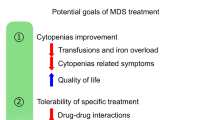Abstract
The EMA86 study showed efficacy of intensive sequential chemotherapy with mitoxantrone, 12 mg/m2 day on days 1–3, etoposide, 200 mg/m2/day as a continuous infusion on days 8–10 and cytarabine (araC), 500 mg/m2/day as continuous infusion on days 1–3 and 8–10 (EMA regimen) in previously treated patients with AML. The goal of the EMA91 study was to determine whether administration of GM-CSF between the two sequences of EMA chemotherapy and during the second sequence could increase therapeutic efficacy by potentially increasing leukemic cell recruitment into the S phase of cell cycle before the second sequence. One hundred and ninety-two patients aged less than 65 years with previously treated AML received GM-CSF, 5 μg/kg/day or placebo from day 4 to day 8 of EMA chemotherapy. One hundred and twenty were refractory and 72 were in first relapse after a complete remission (CR) of more than 6 months duration. CR rates after one course of chemotherapy were 65% in the GM-CSF group (refractory: 51%; first relapse: 89%), not significantly different from the 59% CR rate (refractory: 46%; first relapse: 81%) in the placebo group. Median time to recovery of neutrophils was 38 and 37 days and median time to last platelet transfusion 32 and 32 days respectively in the GM-CSF and placebo groups. WHO grade ≥ 3 non-hematologic toxicities were mainly sepsis (45% and 51%, respectively) and mucositis (34% and 31%) and did not differ between the two groups. Toxic death rate was 5% and 8%, respectively, in the GM-CSF and placebo groups. Patients achieving CR were scheduled to receive six courses of maintenance with reduced-dose EMA. Time to progression tended to be longer in the GM-CSF group (median 154 vs 115 days, progression-free rate at 18 months 33% vs 19%, P = 0.08), particularly in refractory patients (P = 0.06). However, at the current follow-up, this did not translate into a significantly longer disease-free survival and survival. Cell cycle studies showed increased recruitment of cells in the S phase between day 4 and day 8 in the GM-CSF group compared to placebo (P = 0.006). However, this did not significantly relate to prognosis in this cohort of patients. GM-CSF might marginally increase efficacy of sequential chemotherapy without increasing its toxicity in the absence of any detected relationship between this effect and observed leukemic cell recruitment into the cell cycle.
Similar content being viewed by others
Author information
Authors and Affiliations
Rights and permissions
About this article
Cite this article
Thomas, X., Fenaux, P., Dombret, H. et al. Granulocyte–macrophage colony-stimulating factor (GM-CSF) to increase efficacy of intensive sequential chemotherapy with etoposide, mitoxantrone and cytarabine (EMA) in previously treated acute myeloid leukemia: a multicenter randomized placebo-controlled trial (EMA91 Trial). Leukemia 13, 1214–1220 (1999). https://doi.org/10.1038/sj.leu.2401474
Received:
Accepted:
Published:
Issue Date:
DOI: https://doi.org/10.1038/sj.leu.2401474
- Springer Nature Limited
Keywords
This article is cited by
-
Salvage regimens using conventional chemotherapy agents for relapsed/refractory adult AML patients: a systematic literature review
Annals of Hematology (2018)
-
Homoharringtonine in combination with cytarabine and aclarubicin in the treatment of refractory/relapsed acute myeloid leukemia: a single-center experience
Annals of Hematology (2013)
-
The role of timed sequential chemotherapy in adult acute myelogenous leukemia
Current Hematologic Malignancy Reports (2008)
-
Effect of priming with granulocyte–macrophage colony-stimulating factor in younger adults with newly diagnosed acute myeloid leukemia: a trial by the Acute Leukemia French Association (ALFA) Group
Leukemia (2007)
-
Role of cytokines in the treatment of acute leukemias: a review
Leukemia (2006)




